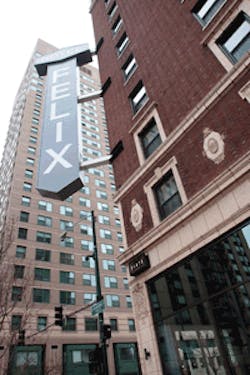Renovated Hotel Felix becomes Chicago’s first LEED Silver hotel
CHICAGO — This April Hotel Felix kicked off Earth Month by unveiling
its U.S. Green Building Council Leadership in Energy and Environmental Design (LEED) Silver certification at a special event members of the media were invited to. The hotel opened in April 2009 after an extensive redevelopment of the 1926 building and received USGBC LEED certification in August 2010, making it Chicago’s first LEED Silver certified hotel.
Some of the hotel’s energy efficient and water conserving features are in-room motion sensors to control heat and air conditioning for a savings of approximately $30,000 per year; water waste reducing plumbing that saves 1 million gallons of water annually; and fluorescent lighting throughout the property that saves nearly $44,000 per year, according to George Jordan, general manager of Hotel Felix Chicago.
According to Richard Hopkins, mechanical engineer at WMA Consulting Engineers, the project’s mechanical contractor, an energy model was created to evaluate different system types, and a heat pump system showed significant savings. The goal was to be 30% below ASHRAE 90.1-2004 Appendix G.
“The lobby and basement are served by a self-contained water cooled VAV air handler with VAV terminals for zone control,” explained Hopkins. “The unit rejects heat to the guestroom condenser water loop. The guestroom toilet exhaust has individual motorized dampers controlled by a wall switch for each room, which allows the central toilet exhaust fan and make-up air unit to turn down on a [variable frequency drive], saving energy.”
In the guest rooms, water-cooled heat pumps with occupancy sensors by FHP Mfg. are utilized. The hotel also has a Baltimore Air Coil cooling tower and three Lochinvar Knight boilers that maintain water temperature in the heat pump loop between 72°F and 84°F year around.
“A guest in one room can call for 80°F and a guest in the next room might want 60°F and both can be accommodated,” said Joel De La Torre, area director of engineering at Hotel Felix. “Since it’s a closed-loop system it’s very efficient.”
When asked by CONTRACTOR what is unique about the HVAC systems in this hotel, Hopkins said most high rise hotels use PTAC units or four-pipe fan coils to condition the guest rooms.
“The heat pump system at Hotel Felix is significantly more efficient than traditional systems as it has a higher overall efficiency and takes advantage of the diversity in the heating and cooling loads,” explained Hopkins. “Also, most hotels have a constant volume toilet exhaust system, making it necessary to supply conditioned make-up air constantly 24/7. The VAV toilet exhaust system at Hotel Felix allows the system to operate at a minimum when the occupancy is low or idle during the day and late at night.”
According to Hopkins, the main challenge during the project was the constraints of a poor existing building envelope and low floor-to-floor height.
“The entire design team had to work closely together to make room for all the mechanical equipment,” said Hopkins. “Also, because the building is historic, only minor improvements were made to the building envelope, therefore, the heating and cooling equipment had to be able to handle a higher moisture infiltration than a new building.”
According to De La Torre, INNCOM e4 Smart Digital Thermostats with occupancy detection were installed in all the guest rooms to accurately determine when to switch to energy-saving setbacks, and when to switch back.
The INNCOM energy management system has deeper setbacks for rooms that are unrented, as opposed to just unoccupied, and will typically reduce heating and cooling run times by 20%-30%.
“In a nutshell, the thermostat turns the unit on when the room is occupied, and when it is not being used or the guest leaves the room it sets back to an energy efficient cycle or mode,” explained De La Torre.
To conserve water, Kohler K-3611 Highline comfort-height toilets and Kohler showerheads were installed throughout the hotel.
“The showerheads use 1.75 GPM flow rate, and Kohler K-3611 toilets deliver complete 3.5-gal. performance in a 1.6-gpf package,” said De La Torre. “So basically a regular toilet uses anywhere from three to four gallons a flush where our toilets use 1.6-gpf, but with the same power and ability of a 3-gal. toilet.”
There is also a possibility that wind turbines will be placed on the roof of the hotel in the near future. Recently wind testing and monitoring were done to ensure the hotel is a good candidate for the technology.
“A third party did a test for two to three wind turbines, and it was successful,” said De La Torre. “We are in a good location for them to be put up.”
Related Articles:
Hotel Andaluz is sustainable, maintains historic charm
Related Articles:
Pre-certified LEED hotel prototype reduces energy use, conserves water
About the Author
Candace Roulo
Candace Roulo, senior editor of CONTRACTOR and graduate of Michigan State University’s College of Communication Arts & Sciences, has 15 years of industry experience in the media and construction industries. She covers a variety of mechanical contracting topics, from sustainable construction practices and policy issues affecting contractors to continuing education for industry professionals and the best business practices that contractors can implement to run successful businesses.
